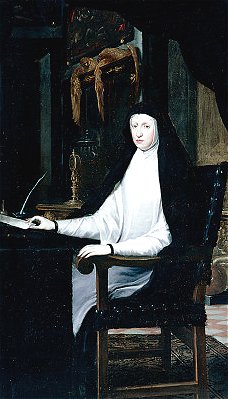 |
|
PORTRAIT OF DONA MARIANA OF AUSTRIA,
QUEEN OF SPAIN AN A WIDOW AND REGENT
Juan Carreno de Miranda Spanish
1614-1685. SN 338 Oil on Canvas
by Robert Anderson. 2000
ARTIST
This Spanish painter was active primarily in Madrid. Until he was
appointed one of the royal painters in 1669 he concentrated on religious works, but
thereafter he worked primarily as a portraitist. One of the most important painters in
Spain in the 17th century, he executed many religious works in oils, tempera and fresco
and was considered to be, after Velazquez, the most acomplished portrait painter of his
day. He was of noble birth and his paintings have an aristocratic dignity and something of
Velazquez's sensitivity and taste. His religious paintings are, however, more
extravagantly Baroque.
His style showed a fully developed and unique manner of combining
compositional schemes inspired by Rubens and other flemish artists with a rich technique
acquired from a careful study of Venetian masters, especially Titian. Carreno's portraits
have an air of stern elegance and reveal an intimate approach to his sitters, no matter
what their social position. He brought to Spanish portrait painting a courtly gallantry
reminiscent of van Dyck, whose works he admired.
Carreno was a long time friend of Velazquez who offered him a position
as a painter in the Alcazar in 1658. In 1669 he was made painter to the King by the Queen
Mother Mariana of Austria, the mother and regent of Charles II. In this new position
Carreno was chiefly engaged in painting portraits. He rendered expressive studies of the
sickly child-king Charles II and several of his mother, Queen Mariana of Austria in severe
widows weeds. These latter portraits were influenced by those of the Queen by Juan
Battista del Mazo. |
SUBJECT
Mariana (whose portrait as an adolescent hangs nearby) was the second
wife of King Philip IV. His first wife, Isabel of Bourbon died in 1649. Mariana had born
Philip two sons: Philip Prosper, who died at the age of four (4) and the future King
Carlos Segundo, Charles II, who assumed the throne at age sixteen in 1677. Charles was
mentally retarded and physically debilitated and after Philip's death in 1665, Mariana
reigned as regent until 1675. The country was actually ruled by her confessor, Johannes
Eberhard Nithard at first and then afterwards by her lover Fernando Valenzuela.
PAINTING
Mariana is shown wearing the habit of a nun (common dress for
royal widows) and seated in the hall of Mirrors in the Alcazar Palace. Her garb is that of
the order of St. Dominic and she is seated in an armchair before a pulpit desk on which we
see paper and a quill pen. In the background what appears to be a monument is seen while
above it hangs a picture depicting the Raising of Lazarus. An oriental rug is on the floor
Carreno's portrait is probably based upon a prototype by the painter
Juan Battista Mazo. Carreno, however, differs from that model in stressing the psychology
of the mature and resiliant Regent whose son Charles II was the last Hapsburg monarch of
Spain.
HISTORICAL CONTEXT
Mariana became Queen at a time when Spain was at war with both Holland
and France. Management of the country, its civil affairs and the management of the war
effort, was left in the hands of one of Philip's ministers, Don Gaspar de Guzman the Count
of Olivares. Philip, himself was much more interested in food, women, art and hunting. The
arts flourished but the country was crushed by high taxes and the defeat on land and sea
by France and Holland. As mentioned above, after Philip's death in 1665, Mariana, as
regent for her son Charles II, left the rule of the country in the hands first of her
confessor Johannes Nithard, then under the control of her lover Fernando Valenzuela.
Decadence became the order of the day. No great literary figure
dignified the age, no great drama took the stage. The universities were languishing amid
the general destitution. Charles the half-idiot son of Philip and Mariana assumed the
government in 1677 and presided helplessly over the debacle. The disintegration of Spain
became a European tragedy and by 1700 Charles signed the country over to the Duke of
Anjou, grandson of the French King. Charles died at the age of thirty-nine (39), the last
Hapsburg ruler of Spain.
|